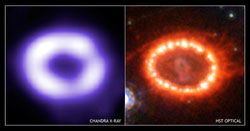Supernova 1987A: Fast Forward to the Past

Credit: X-ray: NASA/CXC/U.Colorado/S.Zhekov et al.; Optical: NASA/STScI/CfA/P.Challis
Recent Chandra observations have revealed new details about the fiery ring surrounding the stellar explosion that produced Supernova 1987A. The data give insight into the behavior of the doomed star in the years before it exploded, and indicate that the predicted spectacular brightening of the circumstellar ring has begun.
The supernova occurred in the Large Magellanic Cloud, a galaxy only 160,000 light years from Earth. The outburst was visible to the naked eye, and is the brightest known supernova in almost 400 years. The site of the explosion was traced to the location of a blue supergiant star called Sanduleak -69º 202 (SK -69 for short) that had a mass estimated at approximately 20 Suns.
Subsequent optical, ultraviolet and X-ray observations have enabled astronomers to piece together the following scenario for SK -69: about ten million years ago the star formed out of a dark, dense, cloud of dust and gas; roughly a million years ago, the star lost most of its outer layers in a slowly moving stellar wind that formed a vast cloud of gas around it; before the star exploded, a high-speed wind blowing off its hot surface carved out a cavity in the cool gas cloud.
The intense flash of ultraviolet light from the supernova illuminated the edge of this cavity to produce the bright ring seen by the Hubble Space Telescope. In the meantime the supernova explosion sent a shock wave rumbling through the cavity.
In 1999, Chandra imaged this shock wave, and astronomers have waited expectantly for the shock wave to hit the edge of the cavity, where it would encounter the much denser gas deposited by the red supergiant wind, and produce a dramatic increase in X-radiation. The latest data from Chandra and the Hubble Space Telescope indicate that this much-anticipated event has begun.
Optical hot-spots now encircle the ring like a necklace of incandescent diamonds (image on right). The Chandra image (left) reveals multimillion-degree gas at the location of the optical hot-spots.
X-ray spectra obtained with Chandra provide evidence that the optical hot-spots and the X-ray producing gas are due to a collision of the outward-moving supernova shock wave with dense fingers of cool gas protruding inward from the circumstellar ring (see illustration). These fingers were produced long ago by the interaction of the high-speed wind with the dense circumstellar cloud.
The dense fingers and the visible circumstellar ring represent only the inner edge of a much greater, unknown amount of matter ejected long ago by SK -69. As the shock wave moves into the dense cloud, ultraviolet and X-radiation from the shock wave will heat much more of the circumstellar gas.
Then, as remarked by Richard McCray, one of the scientists involved in the Chandra research, “Supernova 1987A will be illuminating its own past.”
Fast Facts for Supernova 1987A:
Credit X-ray: NASA/CXC/U.Colorado/S.Zhekov et al.; Optical: NASA/STScI/CfA/P.Challis
Scale Each panel is 2.4 arcsec per side.
Category Supernovas & Supernova Remnants
Coordinates (J2000) RA 05h 35m 28.30s | Dec -69º 16’ 11.10
Constellation Dorado
Observation Dates January 9, 2005
Observation Time 30 hours
Obs. IDs 5579
Color Code Intensity
Instrument ACIS
Also Known As SN 1987A
References S. A. Zhekov, R. McCRay, K. Borkowski, D. Burrows, and S. Park, “Chandra Observations of Shock Kinematics in Supernova Remnant 1987A” , Astrophysical Journal Letters, Volume 628, pp. L127-L130. 2005 (See also astro-ph/0506443)
Distance Estimate About 160,000 light years
Release Date August 17, 2005
Media Contact
All latest news from the category: Physics and Astronomy
This area deals with the fundamental laws and building blocks of nature and how they interact, the properties and the behavior of matter, and research into space and time and their structures.
innovations-report provides in-depth reports and articles on subjects such as astrophysics, laser technologies, nuclear, quantum, particle and solid-state physics, nanotechnologies, planetary research and findings (Mars, Venus) and developments related to the Hubble Telescope.
Newest articles

Properties of new materials for microchips
… can now be measured well. Reseachers of Delft University of Technology demonstrated measuring performance properties of ultrathin silicon membranes. Making ever smaller and more powerful chips requires new ultrathin…

Floating solar’s potential
… to support sustainable development by addressing climate, water, and energy goals holistically. A new study published this week in Nature Energy raises the potential for floating solar photovoltaics (FPV)…

Skyrmions move at record speeds
… a step towards the computing of the future. An international research team led by scientists from the CNRS1 has discovered that the magnetic nanobubbles2 known as skyrmions can be…





















